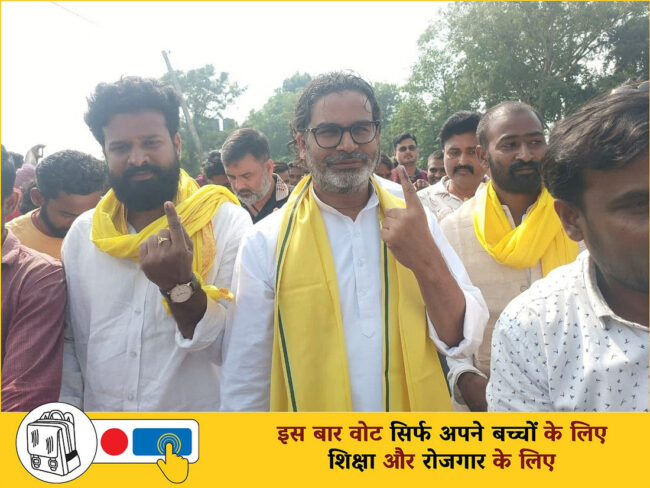 Prashant Kishor’s journey that commened on 2nd October, 2022 from Gandhi Ashram in West Champaran to today’s gloomy tally board in Patna is almost cinematic. For three years he traversed Bihar on foot, claiming to have covered more than 5,000 km and over 5,500 villages, listening to people and promising a politics of governance over jaat and bhaat – a shift from identity and subsistence to dignity and opportunity.
Prashant Kishor’s journey that commened on 2nd October, 2022 from Gandhi Ashram in West Champaran to today’s gloomy tally board in Patna is almost cinematic. For three years he traversed Bihar on foot, claiming to have covered more than 5,000 km and over 5,500 villages, listening to people and promising a politics of governance over jaat and bhaat – a shift from identity and subsistence to dignity and opportunity.
He then converted the Jan Suraaj platform into a political party, fielded candidates on almost every seat (238 of 243), experimented with US-style primaries, promised a “right to recall” and boasted that 90 per cent of his candidates would be first-timers with clean images. Exit polls hinted at a modest but visible vote share, but few seats; even those cautious hopes now look optimistic. Counting day has been crueller still. In constituency after constituency – Siwan, Raghopur, Bhorey, Darbhanga and beyond – Jan Suraaj candidates have ended up as distant also-rans, often buried behind independents and micro-outfits.
For a figure who had confidently declared that if JD(U) crossed 25 seats he would quit politics, and who spoke of anything less than 150 seats for Jan Suraaj as a “defeat”, the contrast between rhetoric and result is stark. So what went wrong – and what does it tell us about the real grammar of Indian politics?
Ai-generated representational image.
1. Crowds are not cadres, and sentiment is not structure
The pad yatra drew impressive crowds. So did his big rallies, where he spoke with fluency about migration, education, health, corruption and the self-respect of Biharis. Visually and on television, it looked like a wave.
But crowds are a very poor proxy for party strength. Elections are won by something far more prosaic: booth committees, ward-level patronage networks, men and women who can get voters out at 7 a.m., keep them motivated through the day and protect the vote at 4 p.m.
Jan Suraaj tried to create an organisation in one big bang – candidate selection, volunteer networks, a digital machine and media messaging – in a state where the established parties have layered structures going back decades. The NDA and the Mahagathbandhan entered this election with well-oiled, assembly-wise pyramids; Jan Suraaj, despite enormous energy, had only a thin first layer. In many seats, its candidates simply did not have the time to become “our person” for any defined cluster of villages or localities.

Sentiment could fill public meetings; it could not, by itself, staff polling booths.
2. No clear social coalition in a deeply socialised polity
Kishor’s central appeal was explicitly post-caste: stop voting on jaat and bhaat (free ration), start voting on jobs, schools, hospitals and honest administration. Normatively, this is attractive. Electorally, in a first-past-the-post system, it is suicidal unless you already have one or two anchor communities behind you.
RJD has its MY-plus-poor coalition; the BJP banks on a layered upper-caste and non-Yadav OBC base topped up by the Modi brand; JD(U) sits atop a Kurmi-Koeri-EBC matrix reinforced by women beneficiaries of welfare and prohibition. Jan Suraaj consciously refused to become the party of any one bloc. That made it morally satisfying but mathematically fragile.
Without a recognisable “us” behind it, the party struggled to convert diffuse goodwill into concentrated votes in any given seat. Exit-poll analyses had already warned that Jan Suraaj might secure a noticeable state-wide vote share and yet struggle to cross the winning line anywhere; the actual results have underlined that warning in red.
3. A third force squeezed by bipolar stakes
This election was framed – by both NDA and Mahagathbandhan – as an existential battle: Modi, stability and welfare on one side; “saving the Constitution”, social justice and checking authoritarianism on the other. In such a high-stakes, high-fear contest, third forces are almost always squeezed.
Much pre-poll commentary suggested that Jan Suraaj would hurt the opposition more than the NDA by attracting the generic “change” vote that might otherwise drift towards the RJD-Congress alliance. Once that perception hardened – that PK was effectively a B-team for one side or the other, depending on who was speaking – risk-averse voters drifted back to the two big blocs.
If you want Nitish out, you vote where it counts; if you fear a return of “jungle raj”, you stick with Nitish and the BJP. Very few voters are willing to “waste” a ballot on a party whose victory they cannot visualise. In the final days, the question was not “Do you like what Jan Suraaj says?” but “Can it form a government?” For most voters, the answer was an obvious no.
4. The leader who refused to contest
Perhaps the single most damaging tactical choice was Kishor’s decision not to fight an assembly seat himself, after months of speculation that he might take on Tejashwi Yadav in Raghopur. In every Indian state where a “good governance” insurgent has succeeded – AAP in Delhi, TMC in West Bengal, BRS in Telangana in its heyday – the leader has put their own name, and ego, on the line.
By staying out, PK looked like a strategist running an experiment on Bihar rather than a leader seeking to be held accountable by Bihar. It undercut his own claim of offering a serious alternative to Nitish and Tejashwi. Voters may listen to a consultant; they rally behind a putative Chief Minister.
It also created a perception problem within Jan Suraaj. Candidates who were being asked to risk their own future, sometimes against very strong incumbents, could fairly wonder why the party’s face was not prepared to do the same.
5. Too much design, too little depth
On paper, Jan Suraaj’s institutional innovations were admirable: internal primaries, talk of right to recall, term limits, and a deliberate bias towards new faces. But building such a rules-heavy party requires at least one full cycle of local elections, years of internal discipline and a culture of compromise.
Instead, the party tried to do everything at once in its very first assembly outing. Many candidates were idealistic but electorally raw; some defected or sulked when tickets did not materialise as expected. Against entrenched MLAs with access to contracts, postings, welfare delivery and informal patronage, this was akin to sending bright MBA graduates to fight hardened thannas without any local “muscle” – social, organisational or financial.
Design replaced depth; process could not substitute for rootedness.
6. The money and media mirage
Kishor made it a point to advertise that he could self-fund his politics from his consultancy income, publicly disclosing that he had earned several hundred crore rupees over a few years and personally ploughed close to ₹100 crore into Jan Suraaj. That bought him advertising, logistics and saturation visibility – and fed television studios’ fascination with the “ace strategist turns politician” narrative.
But money and media mainly change perception among those already attentive. For the marginal voter in Araria or Gopalganj, the core question remains brutally simple: “If I back this symbol and it wins, what can it do for my family and my basti in the next five years?” On that metric, a party with zero proven leverage in Patna, and a chief who might not even be in the House, was at a structural disadvantage.
Television coverage and social-media chatter created an echo chamber in which Jan Suraaj appeared far bigger than it actually was on the ground. The results have punctured that bubble.
7. Nitish, women and welfare: misreading the opponent
Finally, Jan Suraaj seems to have misjudged how entrenched Nitish Kumar’s welfare-and-order brand remains, especially among women. High turnouts were celebrated by Jan Suraaj and parts of the opposition as signs of an anti-incumbency wave. But beneficiary politics in Bihar has matured. Women who appreciate liquor prohibition, girls’ cycles, scholarships, pensions and direct transfers may also be angry about unemployment and out-migration – yet still vote NDA out of habit, gratitude or a sense of comparative safety.
Kishor’s repeated predictions that JD(U) would collapse below 25 seats and that Nitish would not return as Chief Minister after November now look over-confident at best. When such big bets fail, they do not just dent one’s aura; they make the entire project look like a fundamental misreading of the popular mood.
8. The Media Mirage and the Experts Who Misread Bihar
One must also add a note of caution about the role of the mainstream media — especially those converging from Delhi and other state capitals — who dramatically overestimated Prashant Kishor’s impact. Much of the national press placed him centre-stage, amplifying his every statement as if Bihar were poised for a political upheaval. Kishor himself often joked that the media was giving him “forty rupees of publicity for every rupee he spent,” and their coverage almost proved him right. Even the exit-poll professionals, though not predicting double-digit seats, floated comfortable vote-share estimates of around 8–10 per cent. The episode is a reminder that not only observers outside Bihar, but even self-styled electoral experts, can be dazzled into grossly inaccurate forecasts.
What is the lesson – and what does his post-results silence tell us?
A few harsh but useful takeaways emerge for Jan Suraaj and for future “good governance” start-ups:
Attention is not power. Yatras, social-media buzz and think-tank-friendly manifestos are the topsoil; the roots are caste-class anchors, local patron-client ties and booth-level organisation.
Virtue needs a village. A party that talks about governance and dignity has to embed itself in real communities – panchayats, farmer collectives, self-help groups, student unions – years before it aims for state power.
Clarity of side matters. “Equidistance from both” sounds principled but often confuses voters.
The leader must carry risk. If the face of the party will not risk a personal defeat, why should a voter risk their only ballot?
Delivery and identity must work together. Successful reformist parties fuse governance with pride and belonging; they do not pretend identity has vanished.
The post-result optics add an important final layer. Since the scale of the defeat became clear, Prashant Kishor has conspicuously avoided fronting up before the cameras. He has not held a full press conference or given a detailed on-record interview, leaving it instead to a senior Jan Suraaj functionary to declare that the party will undertake a “serious review” of its performance and that he will speak only after the final results and an internal assessment are complete. The contrast between his pre-election confidence and this post-election reticence is striking.
For a man who had publicly staked his political future on this election – promising to step back if the party failed to make a significant impact – that silence is telling. It signals both the enormity of the personal setback and the uncertainty over whether he will now retreat to back-room strategy, persist with Jan Suraaj as a long-term project, or attempt some other reinvention.
Ironically, Kishor may still shape Bihar politics without winning a single seat. His relentless focus on migration, unemployment and governance forced both major alliances to talk more about jobs and less about caste arithmetic. But today’s verdict, and his own studied silence, are a brutal reminder: in Indian politics, you cannot shortcut the slow, unglamorous work of building a party that is rooted in mohallas as much as in television studios. Ideas can ignite a campaign; institutions win elections.